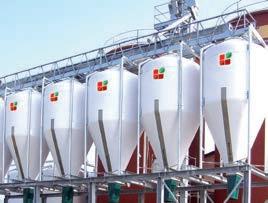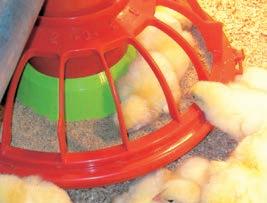
13 minute read
Evaluation of effects of in ovo light stimulation on incubation performance and chick quality in broilers
©Pas Reform
Brian Tainika Department of Animal Productıon and Technologies, Faculty of Agricultural Sciences and Technologies, Niğde Ömer Halisdemir University Özer Hakan Bayraktır - Department of Animal Science, Faculty of Agriculture, Ege University
Advertisement
In sustainable commercial poultry business, hatchability and chick quality are key points that determine the yield and cost of production. Positive results of lighted incubation are highly determined by bioquality of light and egg associated properties.
Although light stimulation during incubation increases chick weight, and hatchability, the findings are inadequate for the general application of this method. Therefore, it is necessary for continuous studies on the mechanisms underlying utilization of various light spectrums, the
interactions of more than two light wavelengths, or in ovo illumination with other supporting methods.
Introductıon
In ovo lighting is an effective embryo management application that can be used to increase efficiency in poultry production via exposing the developing embryos to light by a light source placed within the incubator. In ovo lighting in commercial incubators has become a practical and economical application with the use of Light Emitting Diodes (LED) that are known to prevent overheating, provide the closest spectrum to natural sunlight, as well as monochromatic or bichromatic lighting in addition to features like longevity, durability, and cost-effectiveness (Parvin et al., 2014). Studies that tested LED lights in poultry houses found positive effects on growth performance such as better feed conversion ratios and improved body weight and body weight gains in broilers (Olanrewaju et


al., 2006; Kim et al., 2014; Riber, 2015; Bayraktar et al., 2019) and improved welfare benefits in poultry (Olanrewaju et al., 2015). This has accelerated the transition from conventional incandescent or fluorescent lamps to LED in poultry production. For decades, producers and scientists have been focusing on temperature, humidity, egg turning, and carbon dioxide manipulation to increase hatchability. However, later studies have shown the positive effects of light incubation on the embryo growth rate, incubation period, and post-incubation period. According to Cooper et al. (2011), the photoperiod and the stage at which embryos are stimulated with light are very important factors relating to in ovo light application because the physiological properties of the embryo vary depending on application time and consequently their effects on incubation performance will also differ. Besides, he stated that continuous light exposure to embryos results in early hatching, while light exposure to embryos for 0-12 hours may cause a delay in hatching. Also, light stimulation in the early stages of incubation increases the speed of em-



bryonic development compared to mid and late embryonic photostimulation. Studies to date have also tested different light sources, light spectrums, light intensity, egg eggs were continuously stimulated with the light intensity
size, and eggshell properties for specific roles during incubation, and some findings are summarized below with the highest focus on the green light but, we shall first revise the key proposition of light during embryogenesis.
Light in embryo development The eye and vision system in birds is highly reported as the most advanced sensory organ and their eyesight is superior to humans because they are more sensitive to light intensity, especially blue, green, and red light wavelengths. This is because birds have special additional retinal and deep brain photoreceptors (Lewis and Morris, 2000; Hesham et al., 2018). The effect of light stimulation on embryonic growth and development in poultry depend on the (i) pineal glands and the eye containing fully developed photoreceptors, a circadian clock plus the potential for the rhythmic secretion of melatonin, and (ii) the hypothalamic circadian pacemaker of which these three organs form the poultry circadian system (Dawson et al., 2001). It is assumed that from the 1-2nd day of incubation, light stimulates mitosis in the neural crest mesoderm, the nerve tubes shut off on the 1st day of incubation, and then high light intensity accelerates the embryonic cell proliferation in the process of somite development (Cooper et al., 2011). The chicken retina is the organ that detects light, and the eye has numerous rods and conical photoreceptors that detect and transmit light to the brain, but these photoreceptor molecules are completely developed on the 18th day of embryonic development (Bruhn and Cepko, 1996). On the other hand, the pineal gland is another light-sensing organ in the chick and appears on the 3rd day of embryonic development, and the pineal circadian clocks develop during the last stage of incubation (Cooper et al., 2011). It is well known that when the embryonic pineal gland detects light, melatonin synchronization which is effective on growth and developto cellular levels during embryo development stimulates cAMP to regulate cell metabolism leading to DNA synthesis. Therefore, light regulates gene expression in the early stages of embryonic development and accelerates the growth mechanism and, light stimulation during incubation promotes functional changes in the brain of the chicken embryo (Cooper et al., 2011).
Zhang et al. (2014) investigated how in ovo monochromatic green light changes satellite cell mitotic activity and gene expression in embryonic and post-hatch muscle growth of broiler chickens. In the study, fertile Arbor acres ment is activated. It is documented that light penetration
of 15 lux at the eggshell level using monochromatic green LED light sources of 560nm. They found that light exposure had no significant effect on hatchability, incubation time, and hatch weight. Similarly, the effect of in-ovo monochromatic green light stimulation on embryo and post-hatch development of Cobb strain broilers was evaluated by Rozenboim et al. (2004). Eggs were photostimulated with 5 LED lamps of 560nm and light intensity of 0.1 W/m2 from the 5th day of incubation until hatch. Intermittent light (15 min light, 15 min dark) was used. It was shown that photostimulation did not have a significant effect on hatchability and incubation time.
Shafey and Al-moshen (2002) carried out 3 different experiments at 33, 38 and 41 weeks to determine the effects of continuous monochromatic green light stimulation of broiler breeder eggs on embryonic growth, incubation time, hatchability performance, and chick incubation weight. The green light was provided by two 20-watts green fluorescent light sources during the first 18 days of incubation with a light intensity of 1.340-1.730 on the surface of the eggs. They observed that monochromatic green light stimulation significantly increased hatchability compared to the dark incubation group. Additionally, photostimulated eggs hatched earlier (50% of hatching occurred around 456 hours of incubation) compared to 7% of dark incubation.
Different studies have controversially demonstrated the effect of in ovo monochromatic green light photostimulation on the hatchability and chick quality while it has been shown to increase body and breast muscle weight in the embryonic period. Archer (2017) exposed Cobb 500 broiler embryos to two green LED bulbs of 520nm with a light intensity of 250
lux at the eggshell level using 12L:12D lighting program during the 18th day of incubation. It was found that the number of chicks with unhealed navel was significantly reduced. However, embryo mortality, chick weight at hatch, number of chicks with leg disorders, dirty feathers, and culled chicks were reported to be no different from dark incubation.
Shafey and Al-moshen (2002) studied the effect of monochromatic green light provided by 20 watts green fluorescent light with light intensity (1340 – 1730 lux) at the eggshell surface from the 0-18th day of embryonic development of broiler eggs on incubation performances. It was indicated that photostimulation significantly lowered early and late dead embryos and unhatched eggs with live embryos compared to those incubated under dark conditions. However, in ovo monochromatic green light stimulation significantly reduced chick weight at hatch. Effects of continuous monochromatic light stimulation (560nm green and 480nm blue light) from the 0-21st day of incubation of Arbor acres broilers on breast muscle growth was studied by Zhang et al. (2012). For this purpose, LED lamps were used to provide 15 1x light intensity at the eggshell level. They reported that the body and breast muscle weight of chicks hatched from monochromatic green light stimulated eggs were significantly higher at hatch compared to chicks in the blue and dark incubation groups. In another study that determined the effects of monochromatic light on chick liver development, Arbor acres genotype fertile breeder eggs were incubated under 660nm red light, 560nm green light, 480nm blue light and light intensity at eggshell level was 15 lux. The liver index of chicks obtained from green light stimulated eggs were found to be higher from 6-15% at hatch (Wang et al., 2014).
Tong et al. (2015) examined the effect of 12L:12D photoperiod of green light from the 1st - 18th day of incubation on embryo growth and hatch performance of Ross 308 broilers. Monochromatic light of 522nm was provided by a total of 204 green LEDs. The photoperiod was further manipulated by 1 hour of continuous photostimulation of high intensity (1200-1400 lux) and 11 hours of low light intensity (100-130 lux). They noted that green light stimulation had an effect on beak length on the 10th and 12th, third toe length on the 10th, 14th, and 17th day and crown-rump length on the 10th and 12th day of embryon-
Headquarters CARFED SA POB 2239 CH 6830 CHIASSO Ph. 41. 91. 994.1579 Fax 41. 91. 994.1580
ic development. They concluded that the effects of green light photostimulation did not occur throughout the entire incubation period.
Halevy et al. (2006) conducted a study on the effects of in ovo green light (560nm) with an intensity of 0.1 W/m2 at the eggshell level on skeletal muscle cell proliferation and myofiber growth in post-hatch chicks using LED lamps. The generated heat was eliminated by providing intermittent light (15 min light and 15 min dark) from the 5th14th day of embryonic development. They concluded that green light stimulation promotes skeletal satellite cell proliferation and differentiation in the late stages of chicken embryogenesis in the Cobb genotype chicken embryos.
Effect of other in ovo monochromatic light types on incubation performance and chick quality
Archer (2016) investigated the effect of Cobb 500 broiler embryos from 58 weeks of breeding, exposure to warm (3900 K) or cool (5500 K) light output to chick quality, post-hatching fear, stress, and growth of broiler chickens 208 breed using 5 W bulb type Biolux light sources. It was
at 250 lux light intensity and 12A: 12K photoperiod was used. They showed that LED light stimulation (cool or warm) of embryos significantly increased the percentage Furthermore, exposure to warm and cool light reduced pipped eggs (0.5% and 0.4%) respectively compared with (1.2%) of dark incubation, improved chick quality with decreased unhealed navel percentage of cool (20%) and warm (16%) compared to (41%) of dark treatment. Also, light exposure increased the overall percentage of chicks without defects (82% and 79%) respectively compared to (57%) of dark incubation. However, exposure to light did not affect early, mid, and late embryonic death rate, and unhatched chicks after pipping. Huth and Archer, (2015) evaluated the effects of LED lighting (12L:12D program) during incubation of white (White Leghorn) and brown (Cobb 500 and Ross 308) eggs on the hatchability, embryo mortality and chick quality. During the light program, a 250 lux light intensity on the shell surface was ensured. It was indicated that in ovo lighting in both white eggshell laying hens and broilers increased the number of chicks without defects (75% and 86%) respectively compared to (57%) of dark incubation. Also, they found that LED light incubation of broiler eggs increased hatchability (90%) at hatch compared to (86%) of dark incubation. However, in ovo LED lighting of white layer eggs did not affect hatchability. From a similar study of Archer (2017) photostimulation of Cobb 500 broiler embryos using a 12L:12D photoperiod for 18 days with cool white (7500k) LED light of 250 lux intensity at the eggshell level. It was noted that white LED light stimulation significantly increased hatchability. In the same experiment, 630 nm light wavelength red light exposure to eggs increased hatchability. Hluchy et al. (2012) examined the effects of exposure to blue, green, yellow, and red monochromatic light from the 14th day of embryo development on fertile eggs of Ross
of hatchability (87%) compared to dark incubation (80%). showed that embryos stimulated with white light hatched earlier (499 hours), had the highest hatchability (95%) and average hatch weight of 46 g. In terms of monochromatic light, the hatching time of eggs stimulated with yellow and blue light was (501 and 506 hours) respectively. Furthermore, it was observed that hatchability and chick weight at the hatch for both lights were (94% and 46 g) and (92% and 42 g) respectively.
Effect of in ovo light stimulation with fluorescent and incandescent bulbs
Effect of a 16L:8D photoperiod during incubation (either entire incubation period or the last week of incubation) on embryo growth and incubation performance of Ross 308 broiler breeders was conducted by Ozkan et al. (2012). It was observed that breast muscle weight increased at hatching only when a 16L:8D photoperiod was applied during the 14-21 days of incubation. Also in ovo light stimulation from the 0-21 day of incubation increased embryo weight proportional to egg weight and decreased residual yolk at 13 and 18 days of the embryonic development compared to dark incubation and a 14-21 day in ovo light stimulation. However, no effect was observed on chick weight, relative heart, and liver as a percentage of embryo weight, hatchability, dead embryos, and incubation period. Shafey (2004) investigated the effect of lighting during incubation on embryonic growth and incubation performance of two species of ISA-W and Leghorn breeder eggs laid by chickens at 30 and 31 weeks. The light source was provided by two 20 W white fluorescent 50 cm
tubes placed 12 cm above the eggshell with a light intensity of 1230 to 1790 lux. Continuous light stimulation between 0-18 days of embryonic development significantly increased embryo weight, daily weight gain, and hatchability while the number of unhatched eggs with either live embryos or dead chicks, early and late embryonic deaths was decreased.
Away from chickens, Fairchild and Christensen (2000) examined the effects of in ovo light incubation of turkey eggs with incandescent lamps with an intensity of 107- 139 lux at the eggshell level for 12L:12D photoperiod. It was reported that the hatchability of the light-treated group was higher (83%) compared to incubation in the dark (81%), but this difference was insignificant. Light exposure shortened incubation time where 56% of the poults had hatched at 648 hours of incubation compared with 26% of dark incubation. However, there was no difference between lighted and dark incubation groups for the poult’s body, liver and heart weight, and the mean blood glucose levels.
AirProTec®
Conclusions
In recent years, efforts to use light for the stimulation of embryonic development have gained momentum. Monochromatic lighting where certain wavelengths of light are used in features stands out as a practical and effective method that can be used for this purpose. Based on the findings of various studies, it has been shown that in ovo lighting has no negative effects on the hatchability, but positively affects chick weight and reduction of incubation time. These findings are remarkable to show that in ovo monochromatic lighting has significant effects on both incubation performance and embryonic development. However, it is useful to evaluate these positive effects on incubation and embryo development characteristics on post-hatch performance through further studies. Finally, transferring the results obtained from these and similar studies to the field has the potential to make an important contribution to the national economy by providing an in-
crease in performance as well as chick quality. Reliable protection against PRRS viruses for your stable
AirProTec® fi lter module 20.000
● High reduction rates with PRRS viruses over 95%
● Easy to install

● Very long service life ● Service access for maintenance and cleaning of the system ● Integrated plastic pad cooling system ● Leak test prior to delivery to the customer


Also available: AirProTec® fi lter housing for »ZED« Professional 1800 double ceiling air inlets
REVENTA® GmbH | D-48612 Horstmar | GERMANY | Tel. +49 (0) 25 58 / 93 92 - 0








